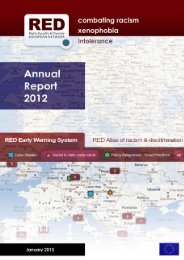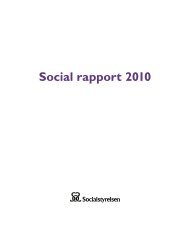R36PITFALLS AND BIASPOLICY AND PRACTICE IN ASSESSMENTAfter D.H. <strong>and</strong> O<strong>the</strong>rs appealed to <strong>the</strong> ECHR, but before <strong>the</strong> Court’s decision, <strong>the</strong> Czech Republic amended itslegislation on education. Most notably, in Section 185 <strong>of</strong> <strong>the</strong> Education Act, <strong>the</strong> term “special schools” was abolished,placing <strong>the</strong> institutions previously so categorized in <strong>the</strong> category “basic schools.” Auxiliary schools, special schoolswhere pupils with mild to moderate intellectual disabilities (<strong>and</strong> thus, <strong>Romani</strong> children who are so diagnosed)are placed, are now termed “special educational needs schools.” Ministerial Decree 73/2005 elaborates on this,establishing <strong>the</strong> forms that special education can take: individual integration, group integration, or education inseparate schools (§3.1.a-c) including special kindergartens, practical elementary schools (formerly auxiliaryschools), <strong>and</strong> special primary schools. Separate primary schools are established for pupils with visual, hearing,vision <strong>and</strong> hearing (deafblind), physical, speech, specific learning <strong>and</strong> behavioral, <strong>and</strong> health disabilities (§ 5), withSection 48 <strong>of</strong> <strong>the</strong> Education Act permitting <strong>the</strong>ir placement in special schools. The ECHR noted in its decisionthat “in many cases special schools had simply been renamed ‘remedial schools’ or ‘practical schools’ without anysubstantial change in <strong>the</strong> composition <strong>of</strong> <strong>the</strong>ir teaching staff or <strong>the</strong> content <strong>of</strong> <strong>the</strong>ir curriculum” (D.H. <strong>and</strong> O<strong>the</strong>rsv. <strong>the</strong> Czech Republic judgment 2007, paragraph 145). Amnesty International (2010) <strong>and</strong> Bedard (2008) note that<strong>the</strong> name change has not brought about any substantive change in <strong>the</strong> way that pupils are taught or placed;pupils who are diagnosed as having special educational needs are still <strong>of</strong>fered a reduced curriculum <strong>and</strong> have notbeen transferred to schools that <strong>of</strong>fer a full curriculum. The Czech government recognizes this in <strong>the</strong> NationalAction Plan for Inclusive Education: in a 2010 study <strong>of</strong> 171 former special schools (out <strong>of</strong> a total <strong>of</strong> 398), <strong>the</strong> CzechSchool Inspection found that only seventeen percent <strong>of</strong> <strong>the</strong>se schools were <strong>of</strong>fering <strong>the</strong> Framework EducationProgram for Elementary Schools (<strong>the</strong> national curriculum) (5).The definition <strong>of</strong> special educational needs conflates disability <strong>and</strong> disadvantage. A disability is considered to bemental, physical, visual, auditory, language/speech, autism or ano<strong>the</strong>r developmental disability (OECD Cross-National Category A), while a disadvantage is related to health or social status. A health disadvantage is defined asa chronic disease or a health impairment that affects a child’s learning or behavior in school (Education Act, §16.1-3,aligned with OECD Cross-National Category B). A social disadvantage is defined, inter alia, as “a family environmentwith a low social <strong>and</strong> cultural status, threat <strong>of</strong> pathological social phenomena” (Education Act, §16.4.a, alignedwith OECD Cross-National Category C). “Pathological social phenomena” are not defined in <strong>the</strong> law. As in o<strong>the</strong>rcountries <strong>of</strong> <strong>the</strong> region, socio-economic status is fused with disability, <strong>and</strong> pupils can be referred to a School AdvisoryFacility for psycho-educational testing based on <strong>the</strong>ir perceived “social disadvantage” <strong>and</strong> subsequently be placed ina practical school or classroom where <strong>the</strong>y are denied participation in <strong>the</strong> whole curriculum, which limits <strong>the</strong>iropportunities for secondary education <strong>and</strong> ultimately, <strong>the</strong>ir participation in <strong>the</strong> labor market.Once a child enters mainstream school, <strong>the</strong>re are many options for what will happen to that child. If a child hasspecial educational needs, it is <strong>the</strong> decision <strong>of</strong> <strong>the</strong> kindergarten director, considering <strong>the</strong> opinion <strong>of</strong> <strong>the</strong> School
R37Advisory Facility or pediatrician, whe<strong>the</strong>r or not to accept <strong>the</strong> child (Education Act §34.6). When a child enterskindergarten, which is not compulsory, directors may, upon notifying legal guardians, remove a child fromkindergarten if (a) <strong>the</strong> child has unexcused absences for at least two weeks; (b) <strong>the</strong> legal guardian <strong>of</strong> <strong>the</strong> child “grossly<strong>and</strong> repeatedly disturbs <strong>the</strong> operations” <strong>of</strong> <strong>the</strong> kindergarten; (c) a pediatrician or School Advisory Facilityrecommends such termination; or (d) <strong>the</strong> family repeatedly fails to pay <strong>the</strong> fees associated with <strong>the</strong> school(Education Act, §35).A child may enter compulsory schooling at <strong>the</strong> age <strong>of</strong> six only if <strong>the</strong> decision is made that <strong>the</strong> child is “physically aswell as mentally adequately mature” (Education Act §36.3); this determination is made by a School AdvisoryFacility. If a child is determined not to be ready for school, <strong>the</strong>re is a possibility to postpone compulsory schoolattendance until <strong>the</strong> age <strong>of</strong> eight under Section 37 <strong>of</strong> <strong>the</strong> Education Act. A pupil can be removed from <strong>the</strong> first year <strong>of</strong>primary education <strong>and</strong> be provided a postponement <strong>of</strong> a year if <strong>the</strong> school director, with <strong>the</strong> consent <strong>of</strong> <strong>the</strong>legal guardian, decides that <strong>the</strong> pupil is not ready to satisfy compulsory attendance; <strong>the</strong> school director, in thiscase, must recommend to <strong>the</strong> legal guardian that <strong>the</strong> child attend preparatory or kindergarten classes to assistin <strong>the</strong> child’s development. Preparatory classes are established specifically for pupils from socially disadvantagedbackgrounds who are determined not ready for <strong>the</strong> first grade <strong>and</strong> for whom “<strong>the</strong>re is a presumption that <strong>the</strong>irinclusion in such a preparatory class may balance out <strong>the</strong>ir development” (Education Act §47.1).A pupil may be placed in a program that <strong>of</strong>fers primary education for pupils with special educational needs or ina special school (or practical primary school) by a school director, upon <strong>the</strong> opinion <strong>of</strong> <strong>the</strong> School Advisory Facility<strong>and</strong> <strong>the</strong> consent <strong>of</strong> <strong>the</strong> child’s legal guardian. The school director is obligated by law to provide <strong>the</strong> child’s legalguardian “information on differences in educational programs <strong>and</strong> organizational changes which could occur inrelation to <strong>the</strong> transfer to a different educational program” (Education Act §49.2). Bedard (2008) reports that <strong>the</strong>transfer <strong>of</strong> pupils to practical (special) schools generally takes place at <strong>the</strong> end <strong>of</strong> <strong>the</strong>ir first year <strong>of</strong> compulsoryschooling. Bedard also questions that, if <strong>the</strong> system <strong>of</strong> primary education has been purportedly equalized, whya recommendation from <strong>the</strong> Pedagogical-Psychological Counseling Center would be required for such a transfer.Before a pupil is transferred to a classroom that <strong>of</strong>fers a different educational program, <strong>the</strong> child might undergoa “diagnostic stay,” which should last between two <strong>and</strong> six months (Decree 73/2005, §9.2). Like diagnostic staysin <strong>the</strong> Slovak Republic, this can be problematic, as pupils in practical (or special) schools typically study a reducedcurriculum, such that <strong>the</strong>y fall fur<strong>the</strong>r behind relative to <strong>the</strong> st<strong>and</strong>ard education curriculum. Ironically, while<strong>the</strong> policy states that a child’s “inclusion … in some form <strong>of</strong> special education” is preceded by <strong>the</strong> diagnostic stay,this stay usually results in <strong>the</strong> child’s exclusion, as most children do not return to a st<strong>and</strong>ard school <strong>and</strong> remain,unintegrated, in <strong>the</strong> school <strong>of</strong> <strong>the</strong>ir diagnostic stay throughout <strong>the</strong>ir school careers (Bedard 2008,36). AmnestyInternational (2010, 35) reports a case where after a four-month diagnostic stay, a pupil returned to his st<strong>and</strong>ardprimary school, but because <strong>of</strong> lost instruction during <strong>the</strong> diagnostic stay, he failed his end <strong>of</strong> year examinations
- Page 3 and 4: R3CONTENTSACKNOWLEDGMENTS 4EXECUTIV
- Page 5 and 6: R5EXECUTIVE SUMMARYThis policy pape
- Page 7: R7For Romani children in Central an
- Page 10 and 11: R10PITFALLS AND BIAS4. Discontinue
- Page 12 and 13: R12PITFALLS AND BIASINTRODUCTIONThe
- Page 14 and 15: R14PITFALLS AND BIASa child is read
- Page 16 and 17: R16PITFALLS AND BIASthe child (Ryan
- Page 18 and 19: R18PITFALLS AND BIASTABLE 2. Placem
- Page 20 and 21: R20PITFALLS AND BIASAMONG THE ROOTS
- Page 22 and 23: R22PITFALLS AND BIASTAXONOMY OF “
- Page 24 and 25: R24PITFALLS AND BIASdevelop the ver
- Page 26 and 27: R26PITFALLS AND BIAS2008, 136). Ard
- Page 28 and 29: R28PITFALLS AND BIASBias in test ad
- Page 30 and 31: R30PITFALLS AND BIASWhile the test
- Page 32 and 33: R32PITFALLS AND BIASOF ROMANI CHILD
- Page 34 and 35: R34PITFALLS AND BIAStwo distinct ty
- Page 38 and 39: R38PITFALLS AND BIASand had to repe
- Page 40 and 41: R40PITFALLS AND BIASOrientation Tes
- Page 42 and 43: R42PITFALLS AND BIASTABLE 5. Educat
- Page 44 and 45: R44PITFALLS AND BIASCOUNTRY-SPECIFI
- Page 46 and 47: R46PITFALLS AND BIASPLACEMENT IN SP
- Page 48 and 49: R48PITFALLS AND BIASCompulsory scho
- Page 50 and 51: R50PITFALLS AND BIASand Educational
- Page 52 and 53: R52PITFALLS AND BIAS121.1.cc.ii). A
- Page 54 and 55: R54PITFALLS AND BIASTest of School
- Page 56 and 57: R56PITFALLS AND BIASof the overall
- Page 58 and 59: R58PITFALLS AND BIASAS WITH OTHER C
- Page 60 and 61: R60PITFALLS AND BIASfirst grade, or
- Page 62 and 63: R62PITFALLS AND BIASbases listed in
- Page 64 and 65: R64PITFALLS AND BIASof Societies in
- Page 66 and 67: R66PITFALLS AND BIASTABLE 13. Pupil
- Page 68 and 69: R68PITFALLS AND BIASROMANI CHILDREN
- Page 70 and 71: R70PITFALLS AND BIASdetermined to c
- Page 72 and 73: R72PITFALLS AND BIASdeveloped in th
- Page 74 and 75: R74PITFALLS AND BIASWechsler Intell
- Page 76 and 77: R76PITFALLS AND BIAStheir chances t
- Page 78 and 79: R78PITFALLS AND BIASREPRESENTATION
- Page 80 and 81: R80PITFALLS AND BIASTABLE 20.Enroll
- Page 82 and 83: R82PITFALLS AND BIAS
- Page 84 and 85: R84PITFALLS AND BIASGOOD PRACTICE A
- Page 86 and 87:
R86PITFALLS AND BIASStudent assessm
- Page 88 and 89:
R88PITFALLS AND BIASThe United King
- Page 90 and 91:
R90PITFALLS AND BIASor assistance i
- Page 92 and 93:
R92PITFALLS AND BIASTeachers report
- Page 94 and 95:
R94PITFALLS AND BIASTHE DETERMINATI
- Page 96 and 97:
R96PITFALLS AND BIASintellectual di
- Page 98 and 99:
R98PITFALLS AND BIAS8. Ensure that
- Page 100 and 101:
R100PITFALLS AND BIASANNEX 1:RELIAB
- Page 102 and 103:
R102PITFALLS AND BIAS1. Does the te
- Page 104 and 105:
R104PITFALLS AND BIASANNEX 2:COMPON
- Page 106 and 107:
R106PITFALLS AND BIASFIGURE A4. Sam
- Page 108 and 109:
R108PITFALLS AND BIASAshton-Warner,
- Page 110 and 111:
R110PITFALLS AND BIASCahn, Claude,
- Page 112 and 113:
R112PITFALLS AND BIASD.H. and Other
- Page 114 and 115:
R114PITFALLS AND BIASFigueroa, Rich
- Page 116 and 117:
R116PITFALLS AND BIASGovernment of
- Page 118 and 119:
R118PITFALLS AND BIASHayman, Robert
- Page 120 and 121:
R120PITFALLS AND BIASKovács-Cerovi
- Page 122 and 123:
R122PITFALLS AND BIASMacura-Milovan
- Page 124 and 125:
R124PITFALLS AND BIASMoore, Tom. 20
- Page 126 and 127:
R126PITFALLS AND BIASRadivojevic, D
- Page 128 and 129:
R128PITFALLS AND BIASShepard, Lorri
- Page 130 and 131:
R130PITFALLS AND BIASTomatová, Jan
- Page 132 and 133:
R132PITFALLS AND BIASVláda Česká
- Page 134:
Copyright © 2012 Roma Education Fu




